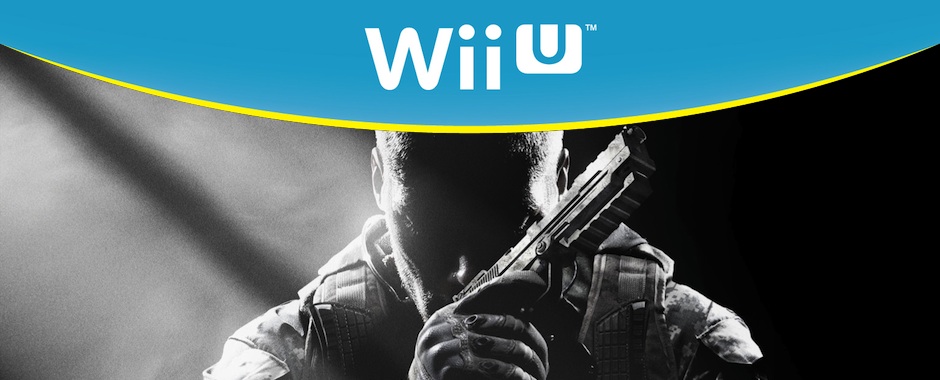We take a look at the Wii U version and its differences.
In our review of Call of Duty: Black Ops II for Wii U, we won’t be discussing the gameplay, story, graphics, or audio again as they remain, for all intents and purposes, identical to the game’s Xbox 360 and PlayStation 3 counterpart. However, we will take a look at the Wii U GamePad controls to see how they change the experience and then repost our original review below it.
Wii U Specifics
Call of Duty is a great game. Unfortunately, the game remains largely the same to other console versions because of a lack of solid implementation of the GamePad controller. In fact, we’d recommend playing the game with the fabulously well-received Pro Controller instead because of its more natural feel when playing a first-person shooter like this.
The GamePad does actually have some extra features such as displaying objectives on its screen for quick glancing, but we actually found this more of a hindrance than we did inherently useful. When we play with a standard controller, we tend to be a bit more relaxed and slouched, but with the GamePad displaying objectives, we had to correct our posture and keep it in our lap. It was also more dangerous in case we got into an intense fire fight and jumped up like we tend to do every once in a while.
Glancing at the GamePad is also undesirable because it is a greater visual distance than it would be to pause the game and check that way. Without pausing the game, you also risk getting fired upon if you’re checking objectives in the middle of a firefight.
You can play the game entirely on the GamePad if you want, which does work out quite well, although the resolution of the GamePad screen means you’re not seeing everything in true 1080p like it was meant to be seen. However, you can take this thing to bed with you if your Wii U is within range, which we certainly can’t argue with.
One option we would have liked since we played without the GamePad most of the time would have been to be able to turn its screen off entirely to save battery. Sure, you might have to keep the controller itself on for whatever reason, but our charging port is up near the television, and it’s just annoying to have to get off the couch and keep it charging through the entire game.
Regardless of what platform you choose, you end up getting largely the same game. We’d probably pick the PlayStation 3 version of the game because its console seems to be the quietest and the game itself is practically identical. With that said, the Wii U version of the game does offer just slightly more variety if you’re into it, but we found it to be more cumbersome than practical. For the game itself, here’s John’s review of Call of Duty: Black Ops II:
Call of Duty: Black Ops II by John Kalanderopoulos, November 20, 2012
The long awaited sequel to Activision’s 2010 Black Ops is here…sort of. When I played the original Call of Duty: Black Ops, I really loved the game. From the story telling, to the characters, to the nature of covert missions; it really was something new for the Call of Dutyfranchise. Then a year later came Call of Duty: Modern Warfare 3, a game that I really loathed because it had been done before, was clichéd, and redundant. I have loved the Call of Dutyfranchise overall as they have developed their story and characters, albeit I have loved it a lot less in recent memories and while Call of Duty: Black Ops II is an improvement over Modern Warfare 3, it doesn’t hold up to the original Black Ops.
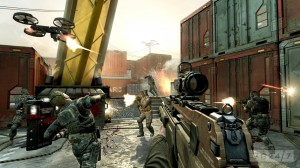 Call of Duty: Black Ops II is a direct sequel to the previous installment. We have two separate and distinct story lines. The first takes place in the past, in what is called the ‘First Cold War’, in the 1980s. This part of the story follows Alex Mason and Frank Woods, both making a return from the first Black Ops. In the original, Alex Mason was brainwashed with the ‘numbers’ in a Russian prison, and Frank Woods was thought to be dead but is actually just captured. Mason goes to rescue Woods early on who serves as the narrator for the story occurring in the past. The 1980s portion of the story continues with Mason and follows Raul Menendez’s, our new antagonist, and his rise to power of a group called Cordis Die.
Call of Duty: Black Ops II is a direct sequel to the previous installment. We have two separate and distinct story lines. The first takes place in the past, in what is called the ‘First Cold War’, in the 1980s. This part of the story follows Alex Mason and Frank Woods, both making a return from the first Black Ops. In the original, Alex Mason was brainwashed with the ‘numbers’ in a Russian prison, and Frank Woods was thought to be dead but is actually just captured. Mason goes to rescue Woods early on who serves as the narrator for the story occurring in the past. The 1980s portion of the story continues with Mason and follows Raul Menendez’s, our new antagonist, and his rise to power of a group called Cordis Die.
Cordis Die, which is Latin for Heart Day, is a very popular group with billions of followers that wish economic equality. Raul Menendez serves as the link between the story taking place in the past, and the second part of the story in the year 2025. A ‘Second Cold War’ has begun between the United States of America and the People’s Republic of China. Menendez has brought cyber terrorism to an art form by crippling China’s economy, and taking over the United States’ military assets and turning them against the country itself. It rests on the shoulders of David Mason, Alex’s son, as a SEAL Commander to stop Menendez’s plan from coming to fruition and saving many of the G20 leaders.
The plot had some hits and misses with me, and that Activision is really missing a great opportunity with their Black Ops games. I really enjoyed the portion of the story that took place in the past. That is where the grittiness of covert operations was brought through. The modern missions felt too much like the Modern Warfare series, and while I did enjoy the first two installments, it did feel like it has been done. It was a lot of just a mass of enemies, who were often shooting at you but rarely hitting, that you had to push through to get to your objective. The problem with the two different timelines, is that too often than not, they didn’t seem like they were related and was just jumping around. The first Black Ops had a strong story because it was able to really mess with your head, and take unexpected twists but still tied everything together, which made the story that much more compelling.
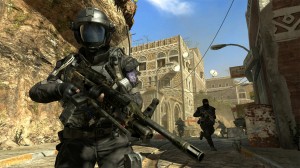 The place where Activision misses a chance is to really bring out what covert missions should be. I would like to see more sneaking around, using forged identification to get through to places, and even more covert infiltration and/or extraction. There are two particular missions that started well down this road but ultimately became just another wave of shooting enemies. In one case, you had to infiltrate a modern facility using forged I.D., and another where you had to use a wing suit to glide into place. I would love to see a HALO insertion, or having to infiltrate a base with a disguise, or something of the sort. Something that is more Mission: Impossible, and less James Bond.
The place where Activision misses a chance is to really bring out what covert missions should be. I would like to see more sneaking around, using forged identification to get through to places, and even more covert infiltration and/or extraction. There are two particular missions that started well down this road but ultimately became just another wave of shooting enemies. In one case, you had to infiltrate a modern facility using forged I.D., and another where you had to use a wing suit to glide into place. I would love to see a HALO insertion, or having to infiltrate a base with a disguise, or something of the sort. Something that is more Mission: Impossible, and less James Bond.
The engine for Black Ops II hasn’t really seemed to change all that much compared with Black Ops or even Modern Warfare 3, and that is a disappointment. When you see recent shooters, like Halo, and they are just beautiful to look at, Call of Duty doesn’t quite seem to measure up. Don’t get me wrong, there are striking visuals, and beautiful scenery, but not at the same level as some recently released titles. For production, the one aspect that Black Ops II has down is the amazing voice talent that is brought to the game. Sam Worthington reprises his role as Alex Mason, and is joined by Michael Rooker, Tony Todd, and Michael Keaton who takes over the role of Jason Hudson from Ed Harris.
This new entry in the Call of Duty series comes with some new game play elements that really try and take the series in a new direction. The first are Strike Force Missions which are optional missions that a player can undertake while playing the campaign mode. These missions are only available within very specific parts of the campaign, and while you can choose not to play them, they will also become unavailable after a certain amount of time. The other interesting part of these new missions is that should you fail, you aren’t given another opportunity to be successful. The failed mission will affect the outcome of the world after the campaign has finished.
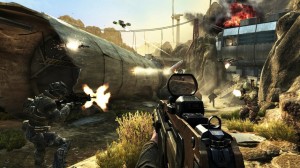 The way it works is that you’re given a goal, and a specific time limit, and a specific set of units to control. You can use the units as an old-fashioned real-time strategy game, and control them from an overhead view. Or you can control any unit on the battlefield from its own perspective to accomplish your objective. The idea was very refreshing but I had two problems with the execution. The first being that I found my team’s AI completely useless and very slow. I ended up controlling one unit or two, and just completing the mission on my own. The second issue I took with these missions is that although they seem to have a variety of different goals, it boils down to you really just protecting one area at some point, and that can get quite tedious. It is a great idea, and with a bit more variety of goals and better units that they could really have something long term, and something that Activision could support with continued Downloadable Content.
The way it works is that you’re given a goal, and a specific time limit, and a specific set of units to control. You can use the units as an old-fashioned real-time strategy game, and control them from an overhead view. Or you can control any unit on the battlefield from its own perspective to accomplish your objective. The idea was very refreshing but I had two problems with the execution. The first being that I found my team’s AI completely useless and very slow. I ended up controlling one unit or two, and just completing the mission on my own. The second issue I took with these missions is that although they seem to have a variety of different goals, it boils down to you really just protecting one area at some point, and that can get quite tedious. It is a great idea, and with a bit more variety of goals and better units that they could really have something long term, and something that Activision could support with continued Downloadable Content.
Hand-in-hand with the Strike Force Missions are Branching Storylines, a way for each player’s game to have a different ending depending on success (or failure) in the campaign, as well as any decisions made during the story. In some cases, the story could change depending on decisions you made during the campaign, like who to kill, or which route to take in a mission. Or the story’s ending could change considering whether you accomplished certain optional tasks (like rescuing a politician who is under fire). This is a first for any Call of Duty game, and really is a breath of fresh air because it makes me want to play the campaign again, and see how another ending might come about.
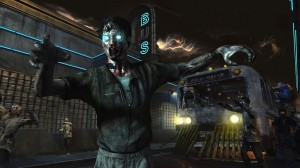 Any gamer will know that in the world of multiplayer gaming, Call of Duty is in a whole other league. Call of Duty ELITE is back and is free for any player who wants it (except for PC gamers, sorry!) but can also be upgraded with a monthly subscription for strategy guides, monthly DLC, and participating in events to name a few. ELITE is used to track your progress online, join a Clan (or create your own), and take part in Clan competitions. And while I am not a big fan of online gaming, I love the idea of ELITE because it enables people to engage in their community outside of just the arena and connect with others who enjoy the game as well.
Any gamer will know that in the world of multiplayer gaming, Call of Duty is in a whole other league. Call of Duty ELITE is back and is free for any player who wants it (except for PC gamers, sorry!) but can also be upgraded with a monthly subscription for strategy guides, monthly DLC, and participating in events to name a few. ELITE is used to track your progress online, join a Clan (or create your own), and take part in Clan competitions. And while I am not a big fan of online gaming, I love the idea of ELITE because it enables people to engage in their community outside of just the arena and connect with others who enjoy the game as well.
And for those who enjoy the latest supernatural renaissance that is occurring in pop culture, Zombies is back. There is a new story mode associated with Zombies, which give it its own mini-campaign, and the popular Survival Mode where the basic idea is that you have to survive for as long as possible. Let me get one thing out first: I am biased right off the back because I don’t like zombies, I don’t understand the fascination with zombies, I don’t understand the appeal of zombies, and so all in all, I don’t like this part of the game. That being said, I probably wouldn’t like this part of the game whether it was zombies or just random bad guys, especially in survival mode. I find something very unrewarding, or unsatisfying about a game that requires me to die in order for it to finish. There is no mission, no objective, just survive and the game doesn’t end until you die. It’s anti-climactic in a way because you know the end result, and there is nothing you can really do to change that.
 In true Call of Duty tradition, Black Ops II is released with multiple retail versions available. I have already spoken at length about limited or collector’s editions, and their allure and this latest game does nothing to change my opinion on the matter. I was lucky enough to receive the Hardened Edition for the PS3 to review, and I have to say Activision does a great job with packaging their products. Included with the steelbook version of the game, is some downloadable content, as well as an official challenge coin. I still have the Call of Duty: Black Ops medal on my shelf, and this coin will take its place beside it. If you had the money to spend (a rather hefty $180), you could upgrade to the Care Package Edition which included everything in the Hardened Edition with the addition of a remote controlled MQ-27 Dragonfire Drone, all packaged in a large crate resembling a care package from in-game. Activision clearly pulled out all the punches, however, the one complaint I always make is neither of these special editions are available to PC gamers.
In true Call of Duty tradition, Black Ops II is released with multiple retail versions available. I have already spoken at length about limited or collector’s editions, and their allure and this latest game does nothing to change my opinion on the matter. I was lucky enough to receive the Hardened Edition for the PS3 to review, and I have to say Activision does a great job with packaging their products. Included with the steelbook version of the game, is some downloadable content, as well as an official challenge coin. I still have the Call of Duty: Black Ops medal on my shelf, and this coin will take its place beside it. If you had the money to spend (a rather hefty $180), you could upgrade to the Care Package Edition which included everything in the Hardened Edition with the addition of a remote controlled MQ-27 Dragonfire Drone, all packaged in a large crate resembling a care package from in-game. Activision clearly pulled out all the punches, however, the one complaint I always make is neither of these special editions are available to PC gamers.
How can I possibly conclude this review by saying anything other than get this game? It has so much content that even if you’re not a fan of one aspect, there is so much more to explore otherwise. I am a very big proponent of story driven game play, and while Black Ops II had aspects that were very engaging and different endings depending on the choices made, it still didn’t quite match the quality of its predecessor. The new Strike Force Missions are a welcome component, and while not up to the Call of Duty standard yet, given time it could really be great. Multiplayer is back, and better than ever with new perks, and ways to customize your own play and with ELITE, you are able to track your progress on your own or with your clan. The price tag that comes with this game doesn’t really do it justice because of the sheer volume of content that you can derive from this game. Activision is really trying new things and is able to try to reach out to a wider audience. This is definitely a must buy for any Call of Duty fan, but is also a great spot for people new to the franchise to get into it just because of the variety of game play available.
Editor’s Note: This review is based on a retail copy of the PlayStation 3 version of Black Ops II provided by Activision.

